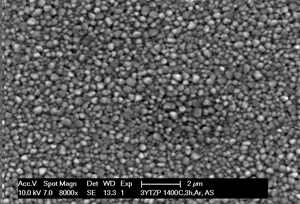 The mechanical loss associated with GB sliding has been measured by using mechanical spectroscopy. More precisely we have studied zirconia specimens differing from one another by the impurity content (volume fraction of the inter-granular glassy phase), by the grain size and by additions of second phase SiO2 particles or nano-fibers such as carbon nanotubes. The mechanical loss is the highest in SiO2 doped 3Y-TZP samples, and so is the creep rate. On the contrary, the high temperature mechanical loss decreases with additions of carbon nanotubes, which can pin the grain boundaries.
The mechanical loss associated with GB sliding has been measured by using mechanical spectroscopy. More precisely we have studied zirconia specimens differing from one another by the impurity content (volume fraction of the inter-granular glassy phase), by the grain size and by additions of second phase SiO2 particles or nano-fibers such as carbon nanotubes. The mechanical loss is the highest in SiO2 doped 3Y-TZP samples, and so is the creep rate. On the contrary, the high temperature mechanical loss decreases with additions of carbon nanotubes, which can pin the grain boundaries.
When an amorphous phase occurs between grains, often because of the sintering aids, it plays an essential lubricating role in the GB sliding process. On the other hand, it allows high-temperature super-plastic deformation, but it deteriorates the mechanical properties, for instance strength and creep resistance above a certain temperature. When GBs are “clean“, the GB sliding takes place by motion of the intergranular dislocations. In order to inprove the mechanical properties at high-temperature the zirconia and alumina polycrystalline ceramics are doped with singlewalled carbon nanotubes, multiwalled carbon nanotubes, silicon carbide particles or silicon carbide whiskers. The undoped and doped ceramic composites are produced by powder metallurgy. SEM and TEM techniques are used to characterize the microstructure of involved material. The sintered samples are carried out into forced torsion pendula.
Publications (2000-2011)
M. Mazaheri, D. Mari, Z. R. Hesabi, R. Schaller and G. Fantozzi Multi-walled carbon nanotube / nanostructured zirconia composites: Outstanding mechanical properties in a wide range of temperature, Composites Science and Technology (2011) accepted
M. Mazaheri, D. Mari, R. Schaller, G. Bonnefont and G. Fantozzi, Processing of yttria stabilized zirconia reinforced with multi-walled carbon nanotubes with attractive mechanical properties. J. Euro. Cer. Soc. (2011) In Press, published online doi:10.1016/j.jeurceramsoc.2010.11.009
M. Mazaheri, D. Mari, R. Schaller, Y. Cai, S. Esmaeilzadeh, and Z. Shen, High-Temperature Mechanical Spectroscopy of Nitrogen-Rich Ca-α-SiAlON Ceramics. J. Am. Ceram. Soc. (2011) In press, published online doi:10.1111/j.1551-2916.2010.04251.x